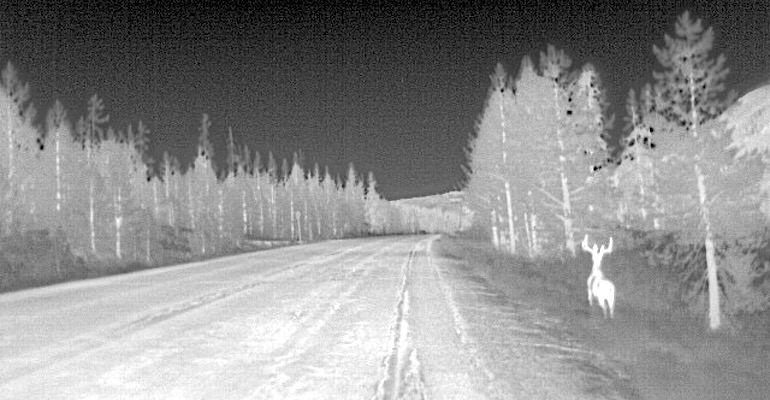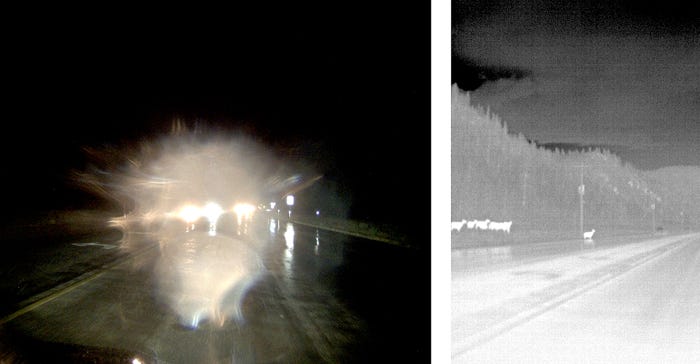AI Unlocks the Safety Potential of Thermal Night Vision Cameras
Adding infrared cameras to vehicles’ ADAS systems can quadruple the detection range for large animals.

Artificial intelligence is bringing new benefits to an old technology, as driver warning systems can use infrared imaging to identify roadside pedestrians and large animals when poor visibility obscures them from normal vision.
Infrared night vision cameras are an old technology, going back to the Hughes night vision systems that General Motors installed on Cadillac and Hummer vehicles two decades ago. The problem with those systems was that a driver strained by the challenge of poor visibility at night or in bad weather didn’t have the ability to also monitor a display showing the night vision image.
So having the ability to spot a deer about to leap into the road from the shoulder and actually doing so proved to be two different things in real-world applications. Today, however, computers are able to monitor the infrared video stream to notify drivers of potential threats.
There is significant safety improvement available to vehicles that can avoid collisions with large animals, as the 2020 State Farm annual study found that there are nearly two million collisions with large animals every year. Those crashes cause 26,000 injuries to people.
Thermal cameras that see infrared wavelengths can detect the heat emitted by animals in the darkness and even through rain and fog. Matching infrared cameras to advanced driver assistance systems (ADAS) like automatic emergency braking not only takes the driver out of the detection task, but also the reaction task, as the car can stop itself if the ADAS system identifies a threat seen through the thermal camera system.
ADAS systems employing Convolutional neural networks can spot large animals in the thermal video stream, just as they do for images obtained by conventional cameras using visible light, from radar, and from lidar units. These systems also identify pedestrians, cyclists, vehicles, and other road objects.
Teledyne FLIR has a thermal vision automotive development kit for its infrared cameras to facilitate the development of ADAS systems that incorporate thermal sensors like the FLIR Boson thermal camera into their sensor suites. The Boson provides 100 meters of vision in the darkness and the camera is available with fields of view of 50, 34, or 24 degrees. It plugs into a common USB interface or optionally into the NVIDIA DRIVE PX 2 interface.

The increased utility of the images from thermal cameras is driving the market for infrared to grow rapidly. Market analyst Mordor Research predicts the global market for infrared cameras will grow from $6.64 billion in 2020 to $10.68 billion by 2026 in its report “IR Camera Market – Growth, Trends, Covid-19 Impact, and Forecasts (2021-2026).” While this total includes military, energy, and commercial industries, the report singles out automotive applications as a driver of this growth, saying “With the increasing demand for advanced driver assistance systems (ADAS) in the future and investments in autonomous cars, IR cameras are expected to witness significant adoption in vehicles.”
"We've really got to get the word out," about the value of AI-backed IR cameras, said FLIR vice president Paul Clayton. "That's what our mission is. That's why we gave away our thermal data set, that's why we're promoting thermal as much as we possibly can in the marketplace, so we can help save lives."
About the Author(s)
You May Also Like





